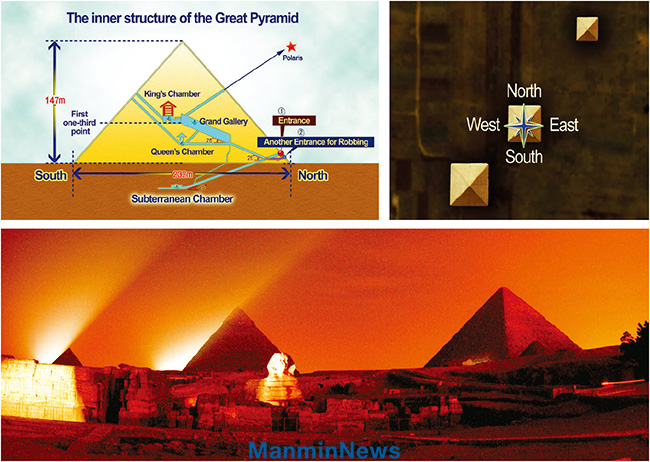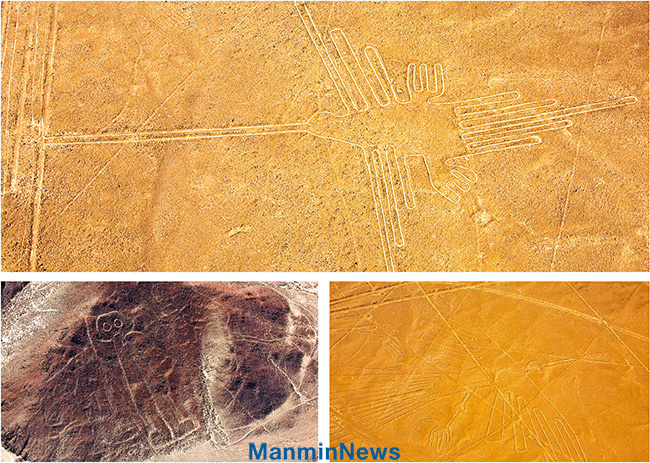








| |

| | Manmin News No. 353 |
| HIT |
12401 |
| DATE |
2013-09-22 |
|
| |
Ancient Wonders! Who made them, and when?
The term, 'Wonders' here refers to the things that are amazing and unimaginable to human beings. There are many ancient remains that are found to be wondrous or mysterious. This is because it seems almost impossible to believe the ancient people could have understood the incredible levels of knowledge and skill with which some of them were built, and that modern technology cannot imitate.
Besides, many things are beyond human imagination. Among the Seven Wonders of the Ancient World is the Great Pyramid. Who could have made it, when and how? And the same questions apply to the Sphinx, the Nazca Lines, and some of the crop circles as well. We have brief answers to the questions, and further details are included in Dr. Jaerock Lee's lectures on Genesis.
The traces of Adam and his descendants from the Garden of Eden
Adam was the first man. He was a living being in the Garden of Eden that was full of abundance. He lived there with great authority as the lord of all things for innumerable years. He ruled over and subdued both the Garden of Eden—the place which God planted for Adam as a living being and his descendants, and the Earth—which God Himself created as the place where Adam would live after his transgression and where human cultivation would take place. Adam fathered many children during this period of time.
As a living being, Adam had a very high level of knowledge and wisdom that God had given to him. With it he made a type of aircraft that he took when he visited the earth. He often visited the area along the Nile River. He wanted to leave something symbolic in the area, so he planned to build a unique and magnificent-sized and -looking structure that would glorify God the Trinity. It was the 'Great Pyramid'. Of course, not all pyramids were constructed by Adam. But it does mean that Adam started the building of pyramids.
After Adam sinned and was driven out of the Garden of Eden, God allowed some of his descendants to travel to the earth at a restricted level. They left the traces of their coming; which are deemed as wonders or mysterious remains now.
The Three Pyramids of Giza in Egypt
The Great Pyramid is 147m tall, and it consists of an estimated 2.3 million limestone blocks, many of which weigh roughly 2.5 tons. Such huge stones were precisely cut and they were fit together very closely and precisely.
The Great Pyramid is calculated to weigh more than 6 million tons. But though it was built many thousands of years ago, it has sunk only 5 millimeters since it was designed to equally distribute its weight over the base. Its base is almost a perfect square, and the 4 base lines of the Great Pyramid almost precisely indicate North, South, East, and West. The 3 pyramids share some similarities with the constellation called Orion.
As explained above, the Great Pyramid was built based on highly technical levels of knowledge and skill in the fields of construction, mathematics, and astronomy.

The Sphinx in front of Pyramid of Giza
This Great Sphinx is located in front of the middle pyramid among the three Pyramids of Giza. This Sphinx appears to guard the three Pyramids. It has a human head and a lion's body, and it faces the East direction. It is about 74 meters long and 20 meters high. This Sphinx was carved from one giant stone. So, we can imagine how huge the original stone was. What is more amazing is that this Sphinx has been well-preserved though immeasurable time has passed.
Nazca Lines
Another mystery is the 'Nazca Lines' of Peru. On the 320-square-kilometer ground on the high plateau of Nazca Desert in southern Peru, about 200 geometric patterns and about 30 animal figures are drawn. Since they are so big, it is impossible to distinguish what they are unless seen from a very high elevation.
For example, a figure of a bird is 120 meters long; there are even geometric lines that stretch about 8 kilometers. A figure of a monkey is 122 meters long and 91 meters wide, and it is drawn with just one continuous line. The drawing of a spider was identified as the rare genus 'Ricinulei,' which is only found in the most remote and inaccessible parts of the Amazon Jungle. Surprisingly, however, the Nazca Desert is too dry and barren for man to inhabit, and there has been no record of humans settling down in this area.

Crop Circles
Another example is the mystery of the Crop Circle. A crop circle is a sizable circular or other geometric pattern created by the flattening of a crop (or grasses) in the middle of a field. They are usually made overnight in a very short period of time. Factors of weather, topography, and natural environment are irrelevant. It is known that some crop circles are made by humans. These man-made crop circles are, however, clearly different from other genuine crop circles. That is, the stems of crops near the man-made crop circles were completely bent, broken and soon withered. On the other hand, the crops near the genuine crop circles continued to grow new stems though their stems were bent.
|
 |
|

